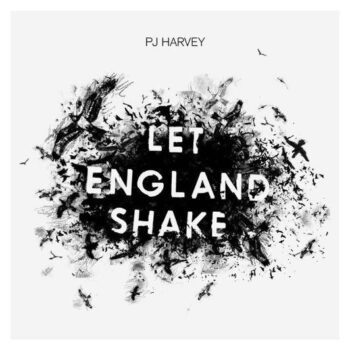
Of the notable rock bands that formed in the early ’90s, a large percentage have either broken up or—even worse—reunited after years-long hiatuses with only half the original lineup. Others have never stopped touring, but everyone acknowledges they’re past their prime; you might pay money to go see Pearl Jam or the Smashing Pumpkins, but that’s because of the music they were making twenty years ago, not the music they’re making now. But in 2011, two decades after her debut, PJ Harvey released what might actually be her best album ever: Let England Shake.
Recorded in a church in Dorset, LES takes as its subjects homeland and war. On it, Harvey sings about the love/hate relationship she has with her country and the grim realities of war for everyone involved. Many of the tracks are protest songs, but not in the way you normally think of protest songs. There’s no sloganeering, and the lyrics are neither overly earnest nor bitingly sarcastic. Instead, as Harvey discussed in an interview with her local paper, she drew on “interviews of people who had actually been there,” from World War I soldiers “right up to present day interviews with Afghani people,” plus reams of English history and war-time works from artists like Goya and Dalí.
The result combines English quintessence (foxhunting horns, descriptions of the Thames) with samples of Kurdish and Jamaican music. Men fall “like lumps of meat” on the battlefield alongside quotes from Russian folk tunes and American rockabilly hits. Defying the constrictions of genre (the Quietus described the first single as “weirdly, part ‘Surfin’ Bird’, part English folk song, part reverb-stunned Cocteau Twins, and part colliery marching brass band”), it’s a record that aims to give voice to soldiers and invaded civilians, the pre-Edwardian and the postmodern, the living and the dead. In short, it’s kind of like a rock-and-roll version of T. S. Eliot’s The Waste Land.
Choosing just one song to write about feels impossible, but I think “The Last Living Rose” captures the paradox of loving one’s country particularly well. Unlike almost all her other videos, which are made by her lifelong friend Maria Mochnacz, the video for this song (and all the other songs on the album) is by Seamus Murphy, a British photographer who has documented wars all over the world.
“Goddamn Europeans,” Harvey spits in the first line. “Take me back to beautiful England.” What makes England so beautiful in comparison to its feckless neighbors to the south? To her (or her narrator), it’s:
…the gray damp filthiness of ages and battered books and fog rolling down behind the mountains over graveyards and dead sea captainsIt’s not exactly a Norman Rockwell painting she describes, but it’s her home, and she’s fiercely loyal to it. Its flaws are flaws she knows with a lover’s intimacy. She wants to “walk through the stinking alleys to the music of drunken beatings” without any bullshit from those goddamn Europeans, thank you very much.
When I sing along to this song with its lyrics about “beautiful England,” I’m conscious that I’m from the United States, not the United Kingdom. But I’m also conscious that a large part of my ancestry is from England. And that another large part of my ancestry is from Ireland, whose messy and violent history with England stands right alongside the conflicts chronicled on the album. And that the last large part of my ancestry is from Brazil, which is its own New World tangle of hell and paradise. And I’m also conscious that this particular mixed-up bloodline is very American—that this melting-pot heritage is one of the best things about America even as the depredations of my English colonist ancestors are one of the worst. Most of all, I’m conscious that I’m just as head over heels in love/hate with my country as PJ Harvey is with hers.
At just under two and a half minutes, “The Last Living Rose” is a slim little song. It’s over almost before it even starts. But while it’s playing, you can feel England—and America and Afghanistan and China and Nigeria and Peru and Egypt—shake.




